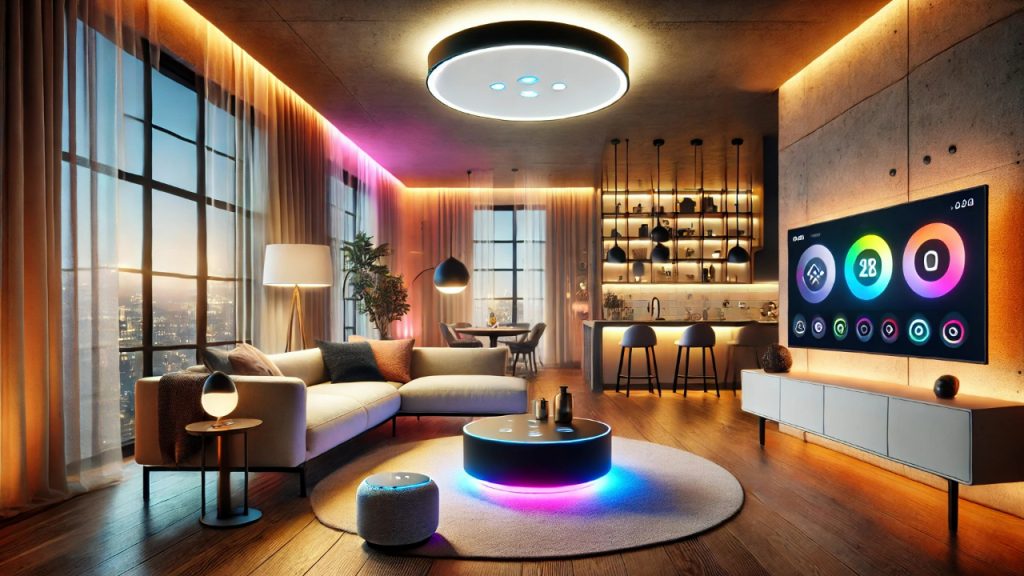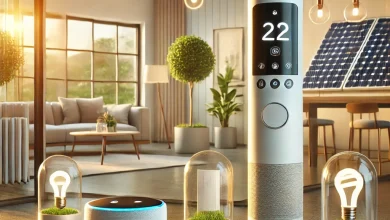Why Smart Lighting is Becoming a Must-Have for Modern Homes
Why Smart Lighting is Becoming a Must-Have for Modern Homes
Smart home technology, over the past couple of years, has revolutionized our lifestyle and has made innovation and convenience part of our daily activities. One of the most popular and impactful advancements in this area is smart lighting. Whether they’re intelligent bulbs that switch colors or systems that adjust to your pattern of life, smart lighting is transforming home environments. But what exactly are the smart lighting must-haves for modern homes? So, here are some factors that are making the adoption of this technology increase steadily.
Convenience and Control
Of all the reasons smart lighting has become so popular, one of the biggest is convenience. Traditional lighting systems can be adjusted only manually, via wall switch or remote. Smart lighting, on the other hand, allows homeowners to easily manage their lights with a smartphone app, voice commands, or automated schedules.
Smart lighting systems can integrate with different smart home platforms like Amazon Alexa, Google Assistant, and Apple HomeKit for better compatibility with other smart devices. You can control the lighting in your home with a quick voice command, allowing you to easily turn a room up or down or adjust the color for your mood or a party.
And remote control means managing your lighting is possible from anywhere — whether in the next room or across the country. Did you leave the lights on before leaving house? Easy — just use your phone to shut them off remotely. It provides a level of convenience that traditional lighting systems simply cannot offer.

Energy Efficiency and Saving Costs
For energy-efficient home enthusiasts, smart lighting offers the chance to save on cost as well as energy. Most smart bulbs use LED technology, which is highly energy efficient. They use a fraction of the electricity of traditional incandescent bulbs, so you’ll see a drop in your utility bills.
Apart from energy efficient bulbs, they often have built-in features that reduce overall power consumption. For example, smart lights can learn when they need to turn off and when they need to slow down based on your movement within the room or repeated usage. You can also program the lights to turn off when you leave your home, meaning that no energy is wasted.
Moreover, some systems support dimming that decreases the energy used by the lights when a lower intensity will suffice. The ability to decide when your lights will be brighter or dimmer across the hours of the day and night means you only use as much energy as you require, helping towards a greener, and more sustainable home.
Customization and Ambience
Perhaps the best thing about smart lighting is that you can set it up to build moods or get work done, however you prefer. There are so many bulbs and fixtures at your disposal, allowing you to select the appropriate color temperature, brightness, and even the color itself, depending on the mood you wish to convey.
So, you can easily set the mood in the living room by dimming the lights and selecting a warm, soft light. On the flip side, you may want bright, cool lighting in the kitchen while you’re cooking or in your home office while you’re working. Most smart lighting offerings also let you change the color of the lights, so the customization options are essentially limitless. Whether you’d like to transform your space into a lively, party-like atmosphere or create a peaceful and intimate escape, smart lighting can make it happen at the press of a button.
Additionally, the lighting systems can be timed to turn on and off depending on the time or events. Fluctuating light levels would allow your lights to gradually brighten in the mornings to slowly wake you up or gradually dim in the evenings to signal that it’s time to start winding down and getting ready for bed. Automating lighting for certain times and activities can bring practicality and luxury to the home.
4. Security and Safety
Smart lighting can enhance the safety and security of your home, offering peace of mind for homeowners. One of the most popular features is the ability to program your lights to turn on and off at specific times, simulating the presence of someone at home even when you’re away. This can be particularly useful when you’re on vacation or traveling for work, as it can deter potential burglars by giving the impression that the house is occupied.
Additionally, motion sensor lights are a key component of many smart lighting systems. These lights automatically turn on when they detect movement, providing illumination when you walk into a room or approach your front door. This feature can also be useful in outdoor areas, such as pathways, driveways, and garages, where motion-activated lights can increase visibility and prevent accidents.
Some smart lighting systems even offer advanced features such as integration with security cameras or alarms. If a security system detects a potential threat, your lights may flash or turn on to alert you, adding an extra layer of protection to your home.
5. Increased Home Value
As smart home technology becomes more prevalent, many homebuyers are looking for properties that are equipped with modern, energy-efficient features. Smart lighting is one of the most sought-after additions to a home, and installing it can increase your home’s appeal and resale value. Potential buyers are likely to appreciate the convenience, energy savings, and security benefits that smart lighting provides.
The integration of smart lighting systems also demonstrates that a home is technologically advanced, which can make it stand out in a competitive real estate market. Whether you’re planning to sell your home soon or simply want to enjoy the benefits of smart lighting while you live there, investing in this technology can be a wise decision.
6. Health and Well-being
The impact of lighting on our health and well-being is more significant than many realize. Traditional lighting, particularly harsh, bright lights, can disrupt our circadian rhythms and negatively affect our sleep patterns. On the other hand, smart lighting allows you to adjust the light temperature to support your natural biological rhythms, promoting better sleep and overall health.
For example, blue light, which is commonly emitted by smartphones, tablets, and fluorescent lights, can interfere with melatonin production and disrupt sleep. Smart lighting systems can be programmed to emit warmer, softer light in the evening to help prepare your body for sleep. Similarly, the ability to simulate natural daylight during the morning can help regulate your sleep cycle and boost your mood.
Additionally, some smart lighting systems are designed to adapt to the amount of natural light in your home, ensuring that the indoor lighting complements the natural light throughout the day. This not only makes your home feel more connected to the outdoors but also supports your mental and physical well-being.
7. The Future of Smart Lighting
As the smart home ecosystem continues to evolve, smart lighting technology is expected to become even more advanced and integrated. Future innovations may include lighting systems that use artificial intelligence to learn your preferences and adapt automatically to your needs, or even smart lighting that adjusts based on your emotional state.
The rise of energy-efficient lighting technologies, such as OLEDs (Organic Light Emitting Diodes) and the continuous improvement of smart home platforms, will only enhance the value and accessibility of smart lighting solutions. With advancements in wireless connectivity and reduced prices for smart bulbs, it’s likely that smart lighting will become an essential feature in every modern home.
Conclusion
Smart lighting has undoubtedly become a must-have for modern homes, offering convenience, energy efficiency, customization, security, and a wealth of other benefits. Whether you’re looking to create a cozy atmosphere, save money on energy bills, or increase the safety of your home, smart lighting offers a comprehensive solution. As the technology continues to evolve, it’s clear that smart lighting will play an even greater role in shaping the future of home living.





